Akal Takht, Punjab.
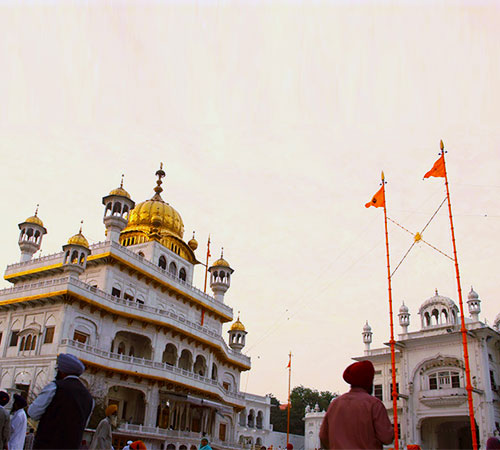
- : Harmandir Sahib, Golden Temple Road, Atta Mandi, Katra Ahluwalia, Amritsar, Punjab, Pin - 143006, India..
- : Nearest airport: Sri Guru Ram Dass Jee International (12.7 km); nearest railway station: Amritsar (1.7 km)..
- : 2.30 am to 10 pm, all days of the week.
- : As per tourists preference. .
- : November to March..
- : Plenty of hotels are present in Amritsar.
 Basic info
Basic info
Akal Takht, where the spiritual and temporal issues of the Sikh community are addressed, was founded by Guru Hargobind Ji on 15th June 1606. It is a very significant site in the holy city of Amritsar and a must-visit place when you are in this city. The word "Akal" means "the timeless one", which signifies the Almighty and the Persian word "Takht" means "throne". Hence, Akal Takht means the "Throne of the Timeless One". It is considered as the highest seat of the head or the principal spokesperson (Jathedar) of the Sikh community. It is located within the Harmindar Sahib complex and is considered the supreme of all the five takhts (seats of power). The other four takhts are Keshgarh Sahib (Anandpur), Patna Sahib, Hazur Sahib, and Damdama Sahib. Guru Hargobind Ji along with Bhai Gurdas Ji and Baba Buddha Ji created the original structure of Akal Takht. The Akal Takht was embellished in gold by Hari Singh Nalwa, who was a general of Maharaja Ranjit Singh. The present building of Akal Takht is a five-story edifice made of white marble with a dome at the top made of gold. Three stories of the present-day structure were built by Maharaja Ranjit Singh in the 1700s. During an Indian Army operation on 4th June 1984, the building was heavily damaged, however, it was rebuilt.
Bhatinda Fort, Punjab.
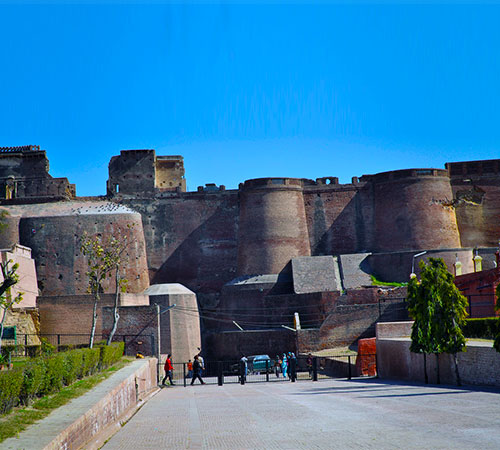
- : 4144, Qila Road, Old City, Bhatinda, Punjab, Pin – 151001, India..
- : Nearest railway station: Bhatinda Junction – 900 m; nearest airport: Amritsar – 204.2 km..
- : 9 am to 5 pm (Monday closed).
- : 2 to 3 hours..
- : October to March..
- : Luxury hotels and lodges are available nearby..
 Basic info
Basic info
Bhatinda Fort, popularly known as Qila Mubarak, is a famous historical fortress located in the Bhatinda City, Punjab. In earlier days, the city of Bhatinda was known as the “Gateway of India”, and has national importance in the sectors of historical, archeological, and industrial. Today, this heritage monument is managed by the Archaeological Survey of India. The presence of this ancient monument in this area had been from 1100 AD. It is said that the construction of this building was started in the Kushana period. Raja Kanishka and Raja Dab commenced the work in 1000 AD.
The main purpose of constructing this building was to provide protection from the Hun attacks. Later, in different periods, different ruler made many alternations and addition in the main fort complex. This famous boat shaped fort was designed perfectly for the desert area as a major portion of Bhatinda was covered with white sand. The fort was constructed by using small sandy bricks and local stones. The fort is around 118 feet in height with 36 bastions.
It is believed that when Mughal Monarch Babar came to India for the first time, he used to stay here. Also, it was the residence of the respected Sikh Guru, Gobind Singh during the 17th century. In 1745, Maharaja Ala Singh captured the fort and started residing here. The first woman ruler of India, Razia Sultana, was imprisoned in this fort around the 13th century.
 Tourist attractions
Tourist attractions
The fort has many other palaces and structures like Moti Palace, Rajmata Palace, Sheesh Mahal, Jail Wala Palace, the Palace of Moon, the Palace of Color, and many more, which are considered as the tourist attractions. There are also two garden houses called “Bagh Ghar” and “Puppet House”. A royal kitchen is also there and it is said that here meals can be cooked for around 35000 people.
Central Sikh Museum, Punjab.
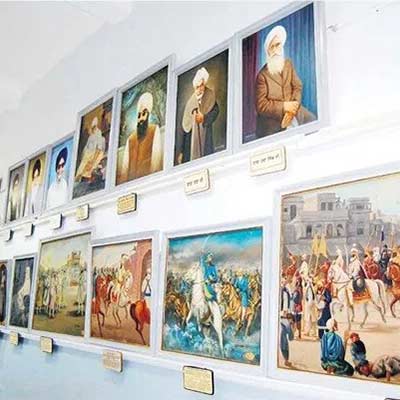
- : Golden Temple Rd, Atta Mandi, Katra Ahluwalia, Amritsar Cantt., Punjab 143006.
- : The nearest airport is Sri Guru Ram Dass Jee International Airport, Amritsar which is 11.0 kilometers away and the nearest railway station is Amritsar Junction railway station from 0.7 kilometers away..
- : All days of the week 7:00 AM - 7:00 PM
- : 1 hour.
- : November and March.
- : Budget & Luxury Hotels are available. .
 Basic info
Basic info
Central Sikh Museum is a museum in Amritsar displaying Sikh history. Established in 1958, it is quite popular among Sikhs as well as tourists. The museum exhibits paintings of Sikh gurus and saints. The museum also demonstrates a lot about Sikh warriors and leaders, who worked for the welfare of Sikhs. There is also a library in the museum, which has paintings by great Sikh artists, pencil sketches, musical instruments, and guns of Sikh Raj. The museum is divided into several halls, based on different aspects of Sikh history. In all, the museum is a must-visit place to gain insights into the history of Sikhism.
Fateh Burj, Punjab.
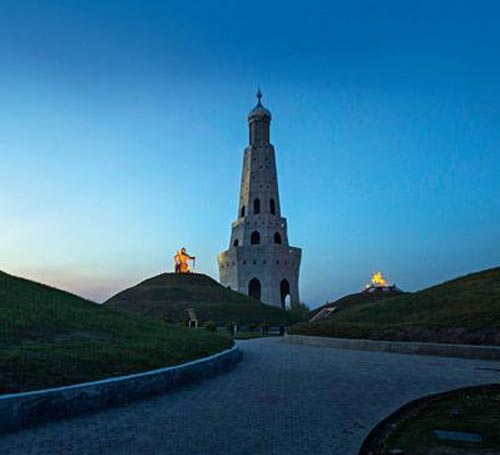
- : Chappar Chiri, Sector 93, Sahibzada Ajit Singh (SAS) Nagar, Punjab, Pin – 140307, India..
- : Nearest Railway Station – Kharar – 8.4 km & Nearest Airport – Chandigarh International Airport – 18.1 km..
- : Tuesday to Sunday, 10 am – 7 pm. (Closed on Mondays).
- : Around 1 hour.
- : October to March..
- : Many budget hotels are available nearby..
 Basic info
Basic info
Fateh Burj, the highest Indian tower to eternalize the memory of the glorious Sikh victory in the war that took place in 1710, between the famous Sikh warrior Baba Banda Singh Bahadur and Mughal Commandant Wazir Khan at Chappar Chiri. Later in 1711, Baba Banda Bahadur Singh commenced the Sikh rule here. The tallest historical monument established on 30th November, 2011, was inaugurated by the former Chief Minister of Punjab, Mr. Prakash Singh Badal. The Fateh Burj, meaning “The Victory Tower” in English, is situated in the historical village of Chappar Chiri, SAS Nagar Punjab. Initially, the align road name was Kharar-Banur Road, which was recently renamed as Banda Singh Bahadur Road.
The historic tower is around 328 feet high and covers around 20 acres of land. This heritage monument complex has a historical museum, auditorium, and Minar-e-Fateh. The octagonal shaped building constructed of steel, stone, and marble is an epitome of architectural beauty. This is a three-storied construction, first story at 67 feet, second at 117 feet and third at 220 feet. The first storey represents the “Victory of Samana”, the second storey represents the “Victory of Sadhura”, and the third represents the “Sirhind of Fought”. Now, this historical monument is managed by the local development authority.
 Tourist attractions
Tourist attractions
Every evening, the authority conducts a light and sound show with color changing effect in the open air auditorium. There is also an auditorium for showing movies and still picture related to the battle, with 100 seating capacity. According to a statistics, almost 2.2 lakh tourists come here to visit this place annually.
Gobindgarh Fort, Punjab.
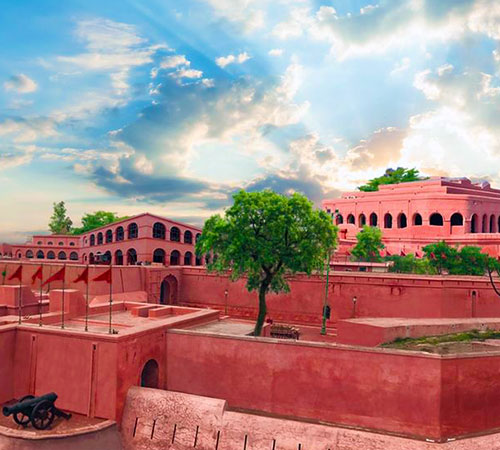
- : Old Cantonment Road, Vijay Chowk, Inside Lohgarh Chowk, Amritsar, Punjab, Pin - 143001, India..
- : Nearest railway station: Amritsar Junction - 0.5 Km; nearest airport: Amritsar - 11.7 km..
- : 10 AM to 10 PM, all days of the week.
- : 2 to 3 hours..
- : October to March is the ideal visiting season..
- : Many tourist lodges and hotels are available in the vicinity..
 Basic info
Basic info
The Gobindgarh Fort, also called as Bhangian Da Qila, was originally built by Gujjar Singh Bhangi in 1760. Later in 1805, the construction work was enhanced by Maharaja Ranjit Singh, the 10th Sikh Guru. After that, in 1849, the British captured the fort and used it as a residence for almost 2000 British soldiers. During that time till independence, the British made significant modifications in this fortress area. After 1947 onwards, the Indian army managed the fort complex very well. Finally, in December 2006, the fort was opened for the public.
The square shaped building was constructed only by brick and lime. The fort has two entrance gates made of iron, Nalwa Gate and Keelar Gate. The main gate Nalwa was named after Hari Singh Nalwa, the commander of Sikh Khalsa. Keelar Gate was the back entry, made of wood and iron. It is said that the Keelar Gate was connected with Lahore through a narrow tunnel. This glorious fort also has 25 cannons and 4 bastions in the main complex.
This historic construction served as the refugee camp during the India-Pakistan partition. During these 257 years of long history of this fort, starting from the Bhangi Era to Sikh, then British and finally the Indian army, a lot of modifications and restoration work have been done. For example, during the Sikh period, unique fortification system, Toshakhana Museum, and Central bungalow were made. During the British period, they made some constructions like the Darbar hall, Chloronome House, etc. were added. Finally, in 2017, again some development work was done like Sher-E-Punjab, Coin Museum, Haat Bazar, Sprit of Punjab, etc.
 Tourist attractions
Tourist attractions
To explore this magnificent monument and witness the historical art and architecture of Punjab, visitors should come here as different types of art forms and local designs are exhibited here like Phulkari, wood inlays, Jutti, Sarkanda Baskets, copper products, and many more.
Jallianwala Bagh, Punjab.
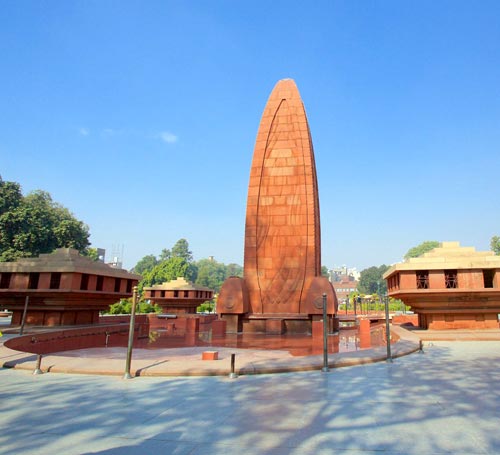
- : Jallianwala Bagh, Golden Temple Road, Amritsar, Punjab, Pin - 143001, India..
- : Nearest railway station: Amritsar - 4 Km; nearest airport: Amritsar - 14.3 km..
- : 6.30 AM to 7.30 PM, on all days in a week.
- : 1 to 2 hours..
- : October to March..
- : Many quality hotels and lodges are there in Amritsar..
 Basic info
Basic info
Jallianwala Bagh, the famous historical place is a civic garden located near the Golden Temple Complex in the Sikh holy city of Amritsar, Punjab. The garden area covers around 6.5 acres and was inaugurated by the former Indian President Dr. Rajendra Prasad in 1951. There is a painful historical significance behind this garden, called Jallianwala Bagh Massacre or Amritsar Massacre that happened on Sunday, dated 13th April 1919, on the occasion of Punjabi New Year and the major Sikh Festival, Baisakhi. As per the historical facts, on that day thousands of Sikhs, Hindus, and Muslims including around 5,000 villagers had gathered in this garden to participate and celebrate the Baisakhi Festival, on whom the British General Dyer ordered his troops to fire bullets. As a result of this firing, thousands of innocent Indians died and many were injured. This incident is marked in the history of Indian freedom struggle as one of the most heart-wrenching and bloodiest events. This beautiful park was built to commemorate the thousands of Indians, who died at the massacre and to immortalize their sacrifice. The centenary of this historic moment will take place in April, 2019.
 Tourist attractions
Tourist attractions
There is a memorial built of red stone in 1961 in the shape of a flame and its base is made of granite.
The narrow entrance, which is the only entryway to the park is a very significant attraction of the park.
The Amar Jyoti or the timeless light is a flame that continuously burns day and night to pay tribute to the martyrs, who lost their lives in the massacre. It is located at the site, where the people had gathered on that fateful day.
Other significant tourist attractions in the park include the martyrs well, martyrs gallery, bullet marks on the walls, and the light and sound show that takes place every evening at 7 pm in summer and at 5 pm in winter.
Mukteshwar Mahadev Temple, Punjab.
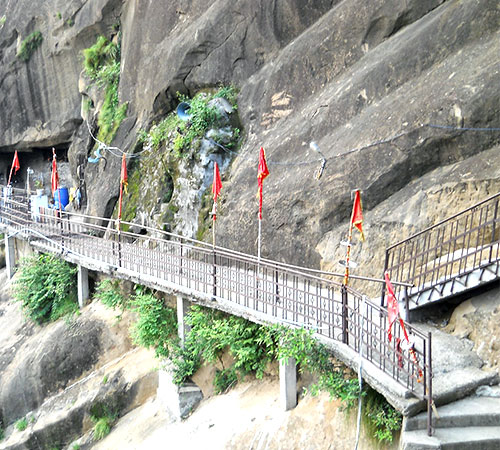
- : Jugial – Dam Road, Doong, Thara Jhikla, Pathankot District, Punjab, Pin – 145029, India..
- : Nearest airport: Pathankot (30.7 km); nearest railway station: Pathankot (24.1 km)..
- : 5 am to 9 pm, Sunday to Saturday.
- : Around 1 hour..
- : October to April..
- : Both luxury and budget hotels are there in Pathankot..
 Basic info
Basic info
Mukteshwar Mahadev temple, also known as Mukesaran Mandir, is the oldest shrine in Pathankot, dedicated to Lord Shiva. The shrine sits on the banks of River Ravi in Doong village. The temple is an ancient rock-cut structure that is placed on a hilltop. There is a shivling made of white marble along with a copper yoni inside the shrine. Also, there are idols of other Hindu gods and goddesses like Lord Brahma, Lord Vishnu, Goddesses Parvati, Lord Hanuman, and Lord Ganesha. Due to its immense religious significance, this temple is also known as the mini (chota) Haridwar. The temple serves as an important landmark of the city of Pathankot and is the most visited spot in the city. Thousands of pilgrims visit this temple every year especially, during Shivratri and other festivals.
 Tourist attractions
Tourist attractions
Qila Mubarak Fort Complex, Punjab.
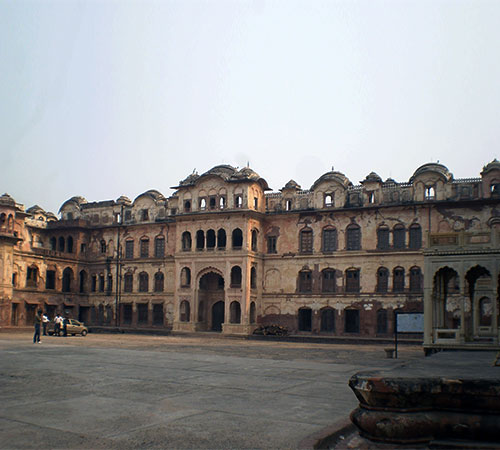
- : Quila Androon, Chandni Chowk, Adalat Bazar, Patiala, Punjab, Pin – 147001, India..
- : Nearest railway station: Patiala - 2.7 Km; nearest airport: Chandigarh International – 62 km..
- : 9 AM to 5 PM from Tuesday to Sunday (Monday closed).
- : 1 to 2 hours..
- : October to May..
- : Many tourist lodges and hotels are available in Patiala town..
 Basic info
Basic info
The founder of the Royal Patiala Dynasty, Baba Ala Singh, was built the Qila Mubarak in the center of Patiala. It was constructed in 1764, later, at the end of the 18th century, Maharaja Amar Singh, made some reconstruction and development work, like Quila Androon. This grand historical palace covers around 10 acres of area.
The fort complex has three important structures – Guest House, also called “Ran Baas”, Darbar Hall or “Divan Khana”, and Quila Androon, the most popular attraction. Quila Androon is the internal part of this palace with 13 royal chambers and designed with mythological and Patiala style wall paintings. It is said that this is the main palace, where the royal families used to reside. This part of the fort complex is designed in the Mughal and Rajasthani style. Another important part of this fort complex is the Qila Mubarak, situated beside the outer wall of the fort. Also, the fort has an advanced underground sewerage system, which represents the rich engineering advancements of that period.
The Durbar Hall, built in 1859, has now been converted into a small museum, where you can see different types and sizes of weapons like sword of Nadir Shah, daggers which belong to respected Guru Gobind Singh, etc. Also, the palace has a resplendent 20-feet high chandelier of Belgium Glass. In the recent past, to preserve this 300-year old ancient monument, development and renovation work has been started by the Archaeological Survey of India and the Indian Cultural Heritage Department.
 Tourist attractions
Tourist attractions
Rambagh Palace and Garden, Punjab.
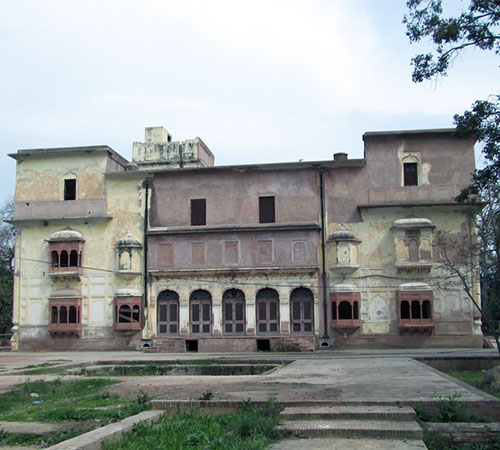
- : M.M. Malviya Road, Inside Mall Road, Ram Bagh, Amritsar, Punjab, Pin - 143001, India..
- : Nearest airport: Amritsar Airport (11.3 km); nearest railway station: Amritsar (2.3 km)..
- : 10 am to 5 pm and Saturday and Sunday 10 am to 9 pm (Wednesday closed).
- : 1 to 2 hours..
- : October to March is the best visiting time..
- : Various accommodation options are available in Amritsar..
 Basic info
Basic info
Rambagh Palace and Garden are closely knitted with the glorious history of Maharaja Ranjit Singh (1780 - 1839), who is known as the founder of the Sikh Empire in Punjab. As a tribute, Maharaja named this palace and garden after Guru Ram Das, who was the founder of Amritsar city. The Rambagh Palace was once used to be the summer palace of the king and the manicured garden that spreads around this magnificent palace is called the Rambagh Garden or Barandari. In earlier times, it was known as the Company Garden. This extensive garden was designed following the beautiful and famous Shalimar Gardens of Lahore and is adorned with splendid fountains, golden fishes, coniferous trees, various herbs and medicinal plants, and an imposing statue of Maharaja Ranjit Singh riding on his horse. Today, it is popularly known as Maharaja Ranjit Singh Garden.
The palace is designed in Indo-Sarcanic architectural style and the construction is mainly of red stone. The palace complex as well as, the garden is declared as a protected area by the Punjab Government and its maintenance and conservation are done by the Archaeological Survey of India. The central building of the palace complex was used by Maharaja as his residence. There used to be a swimming pool for the royal ladies adjoining the palace. The false ceilings of the palace rooms are designed in the Khatamband technique of Kashmir.
 Tourist attractions
Tourist attractions
This palace has now been turned into the Maharaja Ranjit Singh Museum that exhibits different items associated with the life and expeditions of Maharaja like his sword, shield, etc., and portraits of the royal dynasties of Punjab, antique weapons of the Mughal era, and many other historical artifacts. Also, there are replicas of the Kohinoor diamond and a golden throne.
Rangla Punjab Haveli, Punjab.
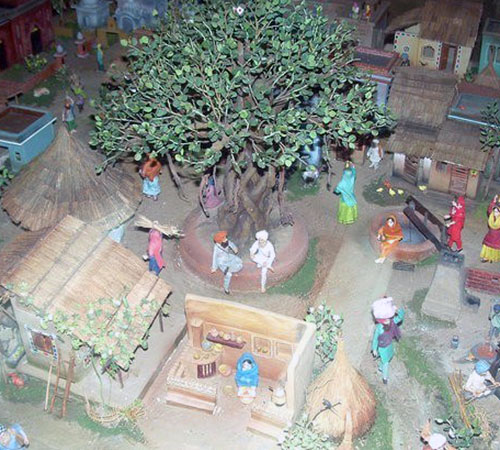
- : Jalandhar - Phagwara Highway, Khajurla, Grand Trunk Road, Jalandhar, Punjab, Pin – 144001, India..
- : Nearest airport - Amritsar (105.1 km); nearest railway station - Jalandhar City (10.9 km)..
- : All days of the week from 12 noon to 4:30 pm and from 6:30 pm to 11 pm.
- : Around 2 hours.
- : The ideal time to visit are the months of April to October..
- : Hotels and resorts are the accommodation options..
 Basic info
Basic info
One of the top attractions in Jalandhar, Rangla Punjab Haveli is a Punjabi themed resort. This place speaks about the grandeur of the rich Punjabi heritage and culture. It is a perfect concoction of the splendor of the Punjabi ethnicity and simplicity of the village life. The exterior of the resort is made of Nanakshahi bricks. As you step inside, you will find many antique paintings, statues, and artifacts adorning the walls. There are beautiful sculptures of men and women busy in everyday chores, such as drawing water from the well, cooking, stitching, and weaving. There is a well in the middle of the hall, which shows how during the olden days, water used to be drawn out of the wells with the help of bulls. The small constructed cubicles are models depicting the Subedar’s house, a jewelry store, and a kitchen with brass utensils. Addition of these minute details adds to the glory of the place.
Along with a traditional themed restaurant, it also has a marriage hall, where ceremonies are conducted. This place is a must visit if you want to experience what living in a Punjabi village feels like.
 Tourist attractions
Tourist attractions
Live musical and dance performances take place inside the enclosure of the Rangla Haveli.
Magic shows, puppet shows, camel rides, horse rides, and other recreational activities are conducted on a daily basis.
A variety of classic vegetarian Punjabi dishes like makkai ki roti, sarson ka saag, kadhai paneer, and many other mouth-watering dishes are being served by the waiters dressed in traditional tehman kurtas and phulkari jackets, adding to the desi flavour of the place.
Shri Devi Talab Mandir, Punjab.
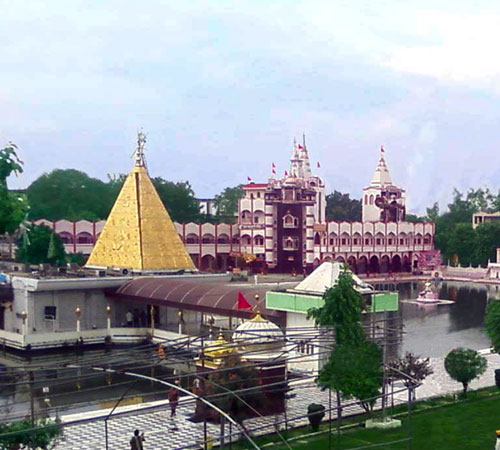
- : Tanda Road, Shiv Nagar, Industrial Area, Jalandhar, Jalandhar District, Punjab, Pin - 144004, India..
- : Nearest airport: Amritsar (93.5 km); nearest railway station: Jalandhar City (2.5 km)..
- : 6 am – 10 pm (Sunday to Saturday).
- : 1 to 2 hours.
- : December to March is the best time to visit (during the annual fair)..
- : Many hotels are there near the temple in Jalandhar..
 Basic info
Basic info
Shri Devi Talab Mandir is one of the oldest and sacred temples in Jalandhar. This ancient shrine, which is more than 200 years old, is situated at the heart of the city and is very well accessible via roadways, railways, and airways. This Durga temple is one of the 51 Shaktipeethas and thus, it is considered highly significant religiously. Lord Shiva is also worshipped here as Bhisan Bhairav and a replica of the Amaranth Cave Temple has been constructed within the temple premises. Also, there is an ancient temple devoted to Goddess Kali, who is worshipped here as Tripurmalini. There is a holy water tank (Talab) near the shrine, which is very old and due to the presence of this talab, the temple got its name. The old temple structure has been renovated some time back. The wall paintings and clay models of gods and goddesses that adorn the temple are truly beautiful.
Along with a traditional themed restaurant, it also has a marriage hall, where ceremonies are conducted. This place is a must visit if you want to experience what living in a Punjabi village feels like.
The Botanical Garden, Punjab.
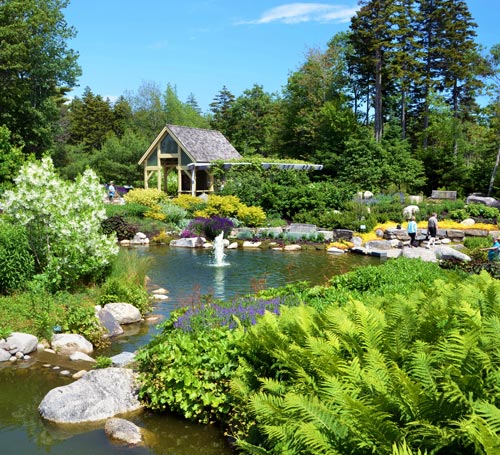
- : Punjabi University Patiala, Urban Estate Phase II, Patiala, Punjab, Pin – 147002, India..
- : Nearest railway station: Patiala- 7.1 Km; nearest airport: Chandigarh – 55.4 km..
- : 8 AM to 6 PM, closed on every Sunday and Government Holidays.
- : Around 2 to 3 hours.
- : October to March..
- : Many tourist lodges and hotels are available in Patiala Town..
 Basic info
Basic info
The Botanical Garden of Patiala is situated in the “City of Garden” - Patiala, Punjab. Actually, this Botanical Garden is a part of the Botany Department of the Punjabi University. It was established in 1972 and the purpose was to perform the conservation and protection role for safeguarding and reducing the loss of plant and vegetation in Punjab. Due to unexpected and unplanned urbanization in the last few decades, the “City of Garden” converted into a large complex of concrete.
The area of this garden covers around 30 acres. The lush garden is also used for education and research purposes as it has many different species of trees of Northern India specifically, the Himalayan Range. The garden also contains a bamboo museum, where different types of bamboo trees are displayed. In this famous garden, there are total 468 types of plant species available - 147 tree species, 23 types of gymnosperm, 78 types of cactus, 43 types of climbers, etc. In the garden, there are some separate areas demarcated for different types of species like Cactus House, Tropical House, Cactus and Canna Garden, Conifer Garden, and many more.
An indoor garden is also there for small trees, different types of colorful flowers, and small hybrid fruits. For research purpose, the garden has two artificial greenhouse centers. A tree called “Saraca Asoca” is planted here under which, it is believed that Lord Buddha was born. In the recent past, the garden authority opened an eco-friendly tree plantation system, with a great aim to increase tree plantation and preserve rare tree species. The garden also has Herbarium and Museum, Photo gallery, Plant Conservatory Center, Poly House – Net House, Herbal garden, etc.
The Golden Temple, Punjab.
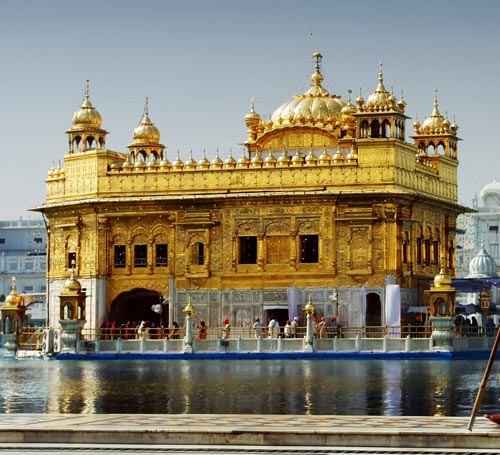
- : Golden Temple Road, Atta Mandi, Katra Ahluwalia, Amritsar, Punjab - 1430006, India..
- : Nearest airport is Amritsar (12.7 km); nearest railway station is Amritsar (1.8 km)..
- : 3 am to 10 pm (every day).
- : 1 - 1:30 hours..
- : April to September is the best visiting time..
- : Although free rooms are available at the temple premise, hotels are also available in the vicinity..
 Basic info
Basic info
The Golden Temple, also known as Shri Harmandir Sahib, is a symbol of equality and brotherhood. It is also known as Darbar Sahib and is the chief Gurudwara of Amritsar and is considered an iconic tourist destination not only in Amritsar but, in the state of Punjab. Hence, it is an important pilgrimage site of the Sikhs. It is built at a lower level than the surrounding land. The temple is built on a small island at the center of the pool, known as Amrita Saras. The four gates of the temple face the four directions, symbolically representing that worshippers from all castes and creeds are welcome into the temple. It is the holiest place to visit in Punjab. During the Afghan invasion, the temple was destroyed many times. During the reign of Maharaja Ranjit Singh, the temple was rebuilt in marble and copper and was covered with gold foil, thus, rendering it the name of Golden Temple.
The Golden Temple is connected to the land on its west side with the help of a marble causeway. At the entrance of the causeway is the Akal Takht, which forms the chief center of the authority of Sikhism. The main entrance of the complex is situated towards the northern side of the pool. The east side of the pool houses the Assembly Hall and the Guru Ram Das Langur Hall, where food is served to thousands of pilgrims on a daily basis. The Tej Singh Samudri Hall, situated at the entrance of the complex houses the main office of the committee, which looks into the functioning of the gurudwaras.
The Partition Museum, Punjab.
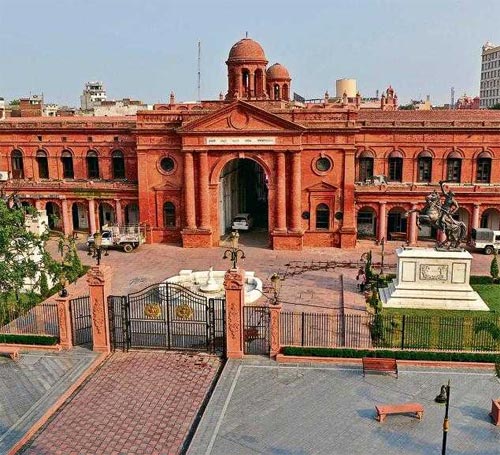
- : Hall Road, Town Hall, Katra Ahluwalia, Amritsar, Punjab, Pin - 143006, India..
- : Nearest railway station: Amritsar - 1.6 Km; nearest airport: Sri Guru Ram Dass Jee International Airport, Amritsar - 11.9 km..
- : 10 AM to 6 PM, Tuesday to Sunday (Monday is closed).
- : Around 2 to 3 hours.
- : November to March..
- : Many tourist lodges and hotels are available in Amritsar city..
 Basic info
Basic info
The popular and world's first museum on the partition of two nations during the independence, named The Partition Museum is located in a red brick building in Amritsar, called the Town Hall. The museum area covers around 17000 square carpet feet. Until the establishment of this grand museum, there was no venue to store and preserve the history of the bloody chapter of independence, the partition of two South Asian giants, India and Pakistan. The purpose of constructing this museum was to safely store and preserve the equipment, photographs, newspaper clippings, donated personal items, documents, archives, Refugees letters, Government documents, etc., which may convey the struggle and how the people suffered during this violent period. It is said that, during this time around 17 lakhs refugees suffered due to migration and the riots that occurred among the Hindus, Muslims, and Sikhs.
To build a world class museum, in 2015, TAACHT (The arts and Culture Heritage Trust) was set up according to the Indian Trust Act, 1882 with the aim of to open and operate a physical museum and memorial hall. On dated 24th October 2016, Punjab Heritage and Tourism Board and TAACHT opened the first part of this museum. Finally on 17th August, at the 70th anniversary of the partition, the Honble Chief Minister Shri Amarinder Singh inaugurated the fully developed all 15 galleries of this museum and dedicated to the people of the nation.
At present, the museum is a part of the recently introduced Heritage Street in Amritsar, which starts from the Golden Temple and ends at the Town Hall Complex. The museum administration actively encourages the Indian as well as, the foreigners to contribute to the information and equipment related to the historical incident. Also, this museum is open for internship and research purposes.
Wagah Border, Punjab.
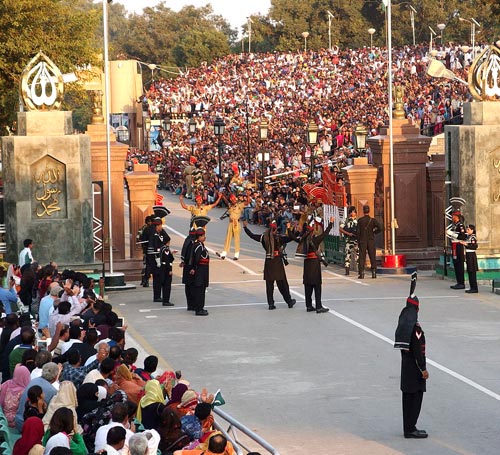
- : Wagah, Hardo Rattan, Punjab, Pin - 143108, India..
- : Nearest airport is Amritsar (39.7 km); nearest railway station is Atari (8.9 km)..
- : All days of the week from 10 am to 4 pm.
- : Around 1 hour..
- : The months from March to September can be considered the best time to visit..
- : Tourist accommodation is not available at Wagah. But, Amritsar, which is at a distance of 34 km, has all sorts of accommodation options..
 Basic info
Basic info
Wagah is the only road border, which passes between India and Pakistan. According to the flag code, the national flag is flown only from sunrise to sunset and so, it needs to be taken down before sunset. Thus, started the Wagah Border Ceremony, previously known as Beating Retreat Ceremony, in the year 1959, on the agreement of both the countries - India and Pakistan.
The Beating Retreat Ceremony, which starts at 4: 15 pm during the winter season and at 5:15 pm during the summer season and lasts for 45 minutes, is a famous tourist attraction. Some of the tallest members of the Indian Border Force and Pakistani Rangers are chosen for the occasion. Soldiers from both the sides synchronize their parade and march towards each other, towards the border and as they reach the border, the gates are opened. They salute each other and start lowering the flags of their respective country. Flags are lowered at the same time, retrieved, and folded. The gates are then slammed shut, and a trumpet is blown to mark the end of the ceremony. The entire session of the ceremony creates a sense of patriotism among the people present at both the sides of the border.
The border gates have visitor galleries on both the sides to provide seating arrangement to the tourists, who come to witness the ceremony. Tourists need to keep in mind certain rules before visiting the Wagah Border. Photography is strictly prohibited in the area. Because of jammers, the mobile network is unavailable. Covered bags, handbags, and purses are not allowed.
War Heroe's Memorial and Museum, Punjab.
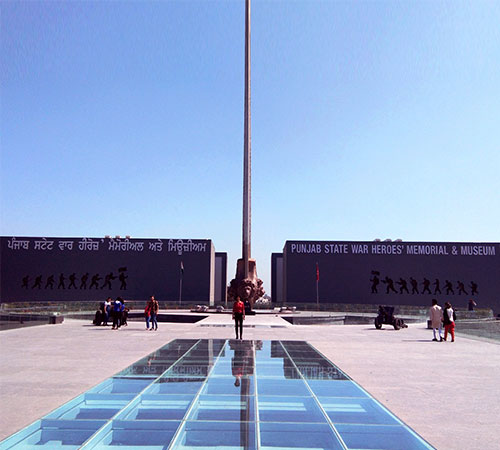
- : Shri Guru Amar Dass Nagar, Chheharta, Amritsar, Punjab, Pin - 143105, India..
- : Nearest railway station: Amritsar Junction - 10.1 Km; nearest airport: Sri Guru Ram Dass Jee International Airport, Amritsar - 15.8 km..
- : 10 AM to 6 PM, (Monday closed).
- : Around 2 to 3 hours..
- : November to March..
- : Many tourist lodges and hotels are available nearby..
 Basic info
Basic info
India's first, famous, and a popular war museum, the Punjab State War Heroes Memorial and Museum is situated on the NH 1, Amritsar, near the India - Pakistan border, known as Wagah Border. This war museum was established in October 2016 and inaugurated by the former Chief Minister of Punjab, Mr. Prakash Singh Badal. The area of the museum complex covers around 4 acres and was designed by Kapoor and Associates, New Delhi. The building follows the traditional as well as, modern style of architecture. The main complex has three parts - two galleries and one museum. The purpose of constructing this memorial museum was to spread awareness among the new generation regarding the bravery, dedication, patriotism, contribution, and sacrifices the Punjabi soldiers had made at different times in different wars. This historical memorial house has many things to explore like different photo galleries, weapons, paintings, artifacts, and many more, from the period of the Sixth Sikh Guru Sri Hargobind Singh to the post-independence war, like till ?Operation Parakram in 2002. The main building has total eight galleries and each of the gallery contains different subjects, like Gallery 1 represents the ?Orientation and Antiquity?, Gallery 2 represents the ?Guru Hargobind Ji till the rise of Sikh Kingdom?, Gallery 3 represents the ?the Sikh Dynasty and Anglo-Sikh Wars?, Gallery 4 shows the ?British Rule Up to Partition (1846 - 1947)?, Gallery 5 shows the Jammu and Kashmir Operation, 1947 - 48?, Gallery 6 depicts the ?Indo-China War 1962?, Gallery 7 represents the ?Indo-Pak Wars (1965-1971)? and finally, Gallery 8 represent the ?Kargil War 1999?.
 Tourist attractions
Tourist attractions
Other attractions are - one 45-meter high stainless steel sword, a MiG-23 aircraft, INS Vikrant, and three tanks. The complex also has a 7D auditorium, where you can watch the realistic activities of different wars. A special light and sound show, organized by the authority every evening is also a major tourist attraction.








